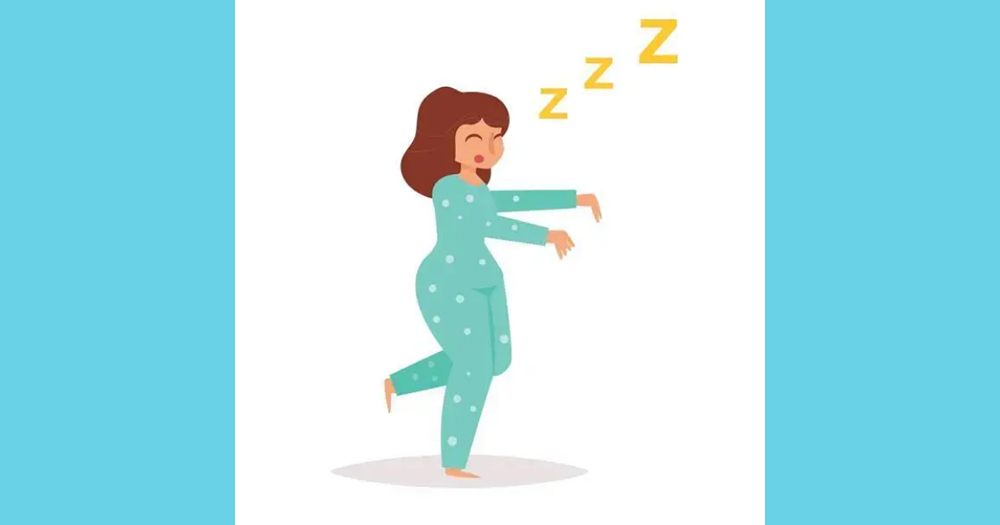Sleep is an extremely vital component of life which stands as a requirement for the human species both for objective and subjective well-being. An adequate amount of sleep can promote overall healthy functionality in all spheres of life. Interrupted sleep hampers the regulation of essential hormones which is necessary to rejuvenate an individual’s spiritual wholesomeness. Disorders of sleep like insomnia and sleep terrors usually require continuous efforts of treatment processes. Similarly, somnambulism also known as sleepwalking is one such sleep disorder that takes place during the deepest non-rapid eye movement and can be characterized by undesirable behavioural experiences during sleep. Patients with the sleepwalking disorder, while remaining in a state of sleeplessness, wake up and start roaming around. There is also a tendency to escape the current physical situation that has been observed. A sufferer of sleepwalking issues usually carries out ordinary activities in sleeping conditions, approximately after 2-3 hours of falling asleep.
The American Psychological Association has not yet regarded sleepwalking as a separate disorder unless it causes an extreme degree of distress and interferes with essential aspects of social and occupational life. Commonly associated symptoms of sleepwalking are:
- Abruptly waking up and beginning to walk around one’s own house.
- Not able to easily wake up from the ongoing episode of sleepwalking even after people try to draw their attention.
- Carrying out a range of different activities apart from walking like eating, talking, urinating and trying to leave the house.
- Having a glazed and glassy-eyed expression and engaging in unusual behaviour like urinating in closet and having sex without awareness.
- Inability to remember the episode after being awakened, memory impairment is also seen in a few cases. (Zadra., et al, 2013).
- Suffering from night terrors in addition to sleepwalking.
- Likely of getting injured during an episode that can involve falling down the stairs.
- Being confused and disoriented after the episode is complete.
- Tendency to become violent or aggressive during or after the episode.
The symptoms sometimes disrupt the individual’s motivation to work and socialize with others. It can also lead to excessive daytime sleepiness and fatigue. The patient’s concentration and efficiency are also compromised. There are several causes due to which chances of such episodes taking place increase. One of the most obvious explanations is the amount of stress in one’s life which bothers his or her psychological peace. Sources of stressors can universally impact all members of a community and it is the root cause for precipitation and maintenance of multiple psychiatric disorders. Medical complications like obstructive sleep apnea, gastrointestinal disease and high fever can also act as a leading factor of sleepwalking. Drug or specific medication uses that include neuroleptics, sedatives and hypnotics can also have various side effects with sleepwalking as one of them. Hereditary factor is one of the principal causes of sleepwalking as it is far more common for it to take place genetically from immediate parents or relatives than by any other source. Hublin and colleagues conducted a retrospective study using an adult Finnish population of twins and found a concordance rate 1.5 times higher in monozygotic than in dizygotic pairs for childhood sleepwalking and 5 times higher in monozygotic than in dizygotic pairs for adult sleepwalking.(Hublin.,et al, 1997). Age also plays a significant role as sleepwalking is more prevalent in children when compared to that of adults. Severe interruptions in sleep schedules that result in a lack of rest can also induce episodes of sleepwalking.
There are a considerable number of methods to deal with somnambulism or sleepwalking that helps in controlling the frequency of the episodes. The most popular suggestion is to improve sleep hygiene where patients are encouraged to maintain a fixed sleep schedule with proper attention focused on the environment where one sleeps. It is also imperative for them to not use electronic gadgets or any intake of caffeine before sleep. Therapists guide patients with sleepwalking issues to learn self-hypnosis where the trained professional promotes a change in the undesirable behaviour during a deep state of relaxation. They are also assisted in executing the approaches that aid in stress reduction and are also motivated to practise relaxation techniques at home on a daily basis. Safeguarding is an extremely necessary step that needs to be taken into consideration whereby all doors and windows are locked and sharp objects are eliminated to further ensure safety. Clients are also advised to maintain a sleep diary that records all of their particular behaviour before and after sleep; this sometimes determines the unnoticed underlying issues.
Although sleepwalking is a less noticeable occurrence when compared to other psychosis and neurosis, it is an essential severe form of parasomnia that intensely affects a person’s physical, social as well as emotional health. A research published on adult sleepwalking in the American Academy of sleep medicine, in 2013, where Dr. Yves Dauvilliers, held that sleepwalking is associated with mood disturbance and daytime sleepiness and he maintained it as a potentially dangerous condition if left untreated. Sleep walking has not been observed in non-human primates and is considered a unique human phenomena which may or may not be due to the repressed hostile unconscious impulses. The only confirmed hypothesis is that constant collective support and care throughout the ongoing issue is to be given to the sufferers in order for them to feel loved and reassured that helps them develop an attitude of preparedness to improve their symptoms and heal.
– Urveez Kakalia and Debanjana Banerjee.

